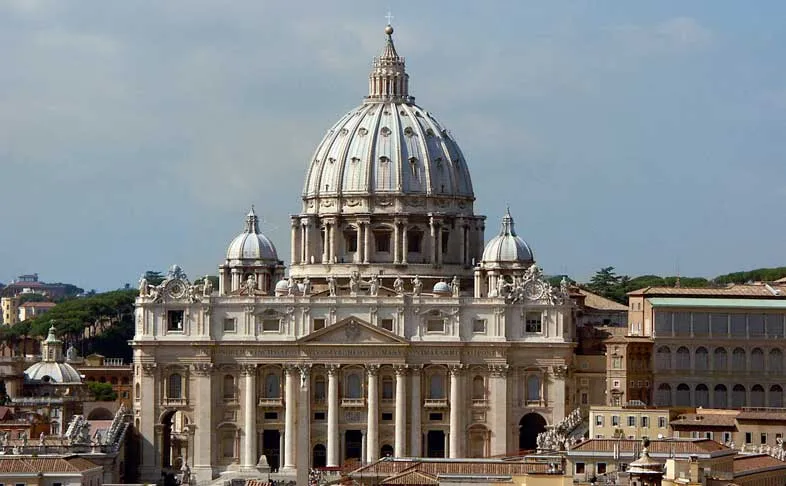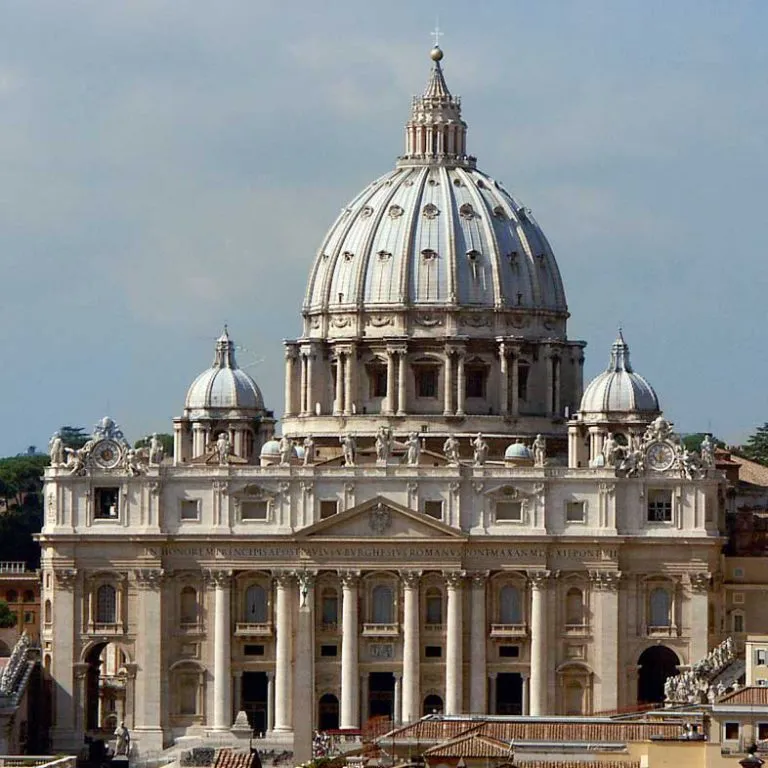
Introduction
The Papal Basilica of Saint Peter in the Vatican (Italian: Basilica Papale di San Pietro in Vaticano), or simply Saint Peter’s Basilica (Latin: Basilica Sancti Petri), is a church built in the Renaissance style located in Vatican City, the papal enclave that is within the city of Rome, Italy. It was initially planned by Pope Nicholas V and then Pope Julius II to replace the aging Old St. Peter’s Basilica, which was built in the fourth century by Roman emperor Constantine the Great. Construction of the present basilica began on 18 April 1506 and was completed on 18 November 1626.
Designed principally by Donato Bramante, Michelangelo, Carlo Maderno and Gian Lorenzo Bernini, St. Peter’s is the most renowned work of Renaissance architecture and the largest church in the world by interior measure. While it is neither the mother church of the Catholic Church nor the cathedral of the Diocese of Rome (these equivalent titles being held by the Archbasilica of Saint John Lateran in Rome), St. Peter’s is regarded as one of the holiest Catholic shrines. It has been described as “holding a unique position in the Christian world”, and as “the greatest of all churches of Christendom.”
Catholic tradition holds that the basilica is the burial site of Saint Peter, chief among Jesus’s apostles and also the first Bishop of Rome (Pope). Saint Peter’s tomb is supposedly directly below the high altar of the basilica, also known as the Altar of the Confession. For this reason, many popes have been interred at St. Peter’s since the Early Christian period.
St. Peter’s is famous as a place of pilgrimage and for its liturgical functions. The pope presides at a number of liturgies throughout the year both within the basilica or the adjoining St. Peter’s Square; these liturgies draw audiences numbering from 15,000 to over 80,000 people. St. Peter’s has many historical associations, with the Early Christian Church, the Papacy, the Protestant Reformation and Catholic Counter-reformation and numerous artists, especially Michelangelo. As a work of architecture, it is regarded as the greatest building of its age.
St. Peter’s is one of the four churches in the world that hold the rank of Major papal basilica, all four of which are in Rome, and is also one of the Seven Pilgrim Churches of Rome. Contrary to popular misconception, it is not a cathedral because it is not the seat of a bishop; the cathedra of the pope as bishop of Rome is at Saint John Lateran.
History of St. Peter's Basilica, Vatican City
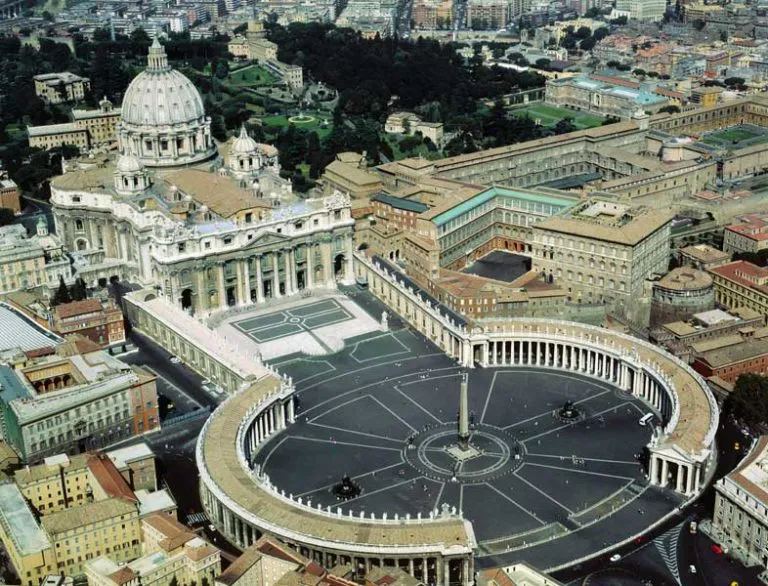
St. Peter’s is a church built in the Renaissance style located in the Vatican City west of the River Tiber and near the Janiculum Hill and Hadrian’s Mausoleum. Its central dome dominates the skyline of Rome. The basilica is approached via St. Peter’s Square, a forecourt in two sections, both surrounded by tall colonnades. The first space is oval and the second trapezoidal. The façade of the basilica, with a giant order of columns, stretches across the end of the square and is approached by steps on which stand two 5.55 metres (18.2 ft) statues of the first-century apostles to Rome, Saints Peter and Paul.
The basilica is cruciform in shape, with an elongated nave in the Latin cross form but the early designs were for a centrally planned structure and this is still in evidence in the architecture. The central space is dominated both externally and internally by one of the largest domes in the world. The entrance is through a narthex, or entrance hall, which stretches across the building. One of the decorated bronze doors leading from the narthex is the Holy Door, only opened during jubilees.
The interior dimensions are vast when compared to other churches. One author wrote: “Only gradually does it dawn upon us – as we watch people draw near to this or that monument, strangely they appear to shrink; they are, of course, dwarfed by the scale of everything in the building. This in its turn overwhelms us.”
The nave which leads to the central dome is in three bays, with piers supporting a barrel vault, the highest of any church. The nave is framed by wide aisles which have a number of chapels off them.
There are also chapels surrounding the dome. Moving around the basilica in a clockwise direction they are: The Baptistery, the Chapel of the Presentation of the Virgin, the larger Choir Chapel, the altar of the Transfiguration, the Clementine Chapel with the altar of Saint Gregory, the Sacristy Entrance, the Altar of the Lie, the left transept with altars to the Crucifixion of Saint Peter, Saint Joseph and Saint Thomas, the altar of the Sacred Heart, the Chapel of the Madonna of Column, the altar of Saint Peter and the Paralytic, the apse with the Chair of Saint Peter.
And also the altar of Saint Peter raising Tabitha, the altar of St. Petronilla, the altar of the Archangel Michael, the altar of the Navicella, the right transept with altars of Saint Erasmus, Saints Processo and Martiniano, and Saint Wenceslas, the altar of St. Jerome, the altar of Saint Basil, the Gregorian Chapel with the altar of the Madonna of Succour, the larger Chapel of the Holy Sacrament, the Chapel of Saint Sebastian and the Chapel of the Pietà.
The Monuments, in a clockwise direction, are to: Maria Clementina Sobieski, The Stuarts, Benedict XV, John XXIII, St. Pius X, Innocent VIII, Leo XI, Innocent XI, Pius VII, Pius VIII, Alexander VII, Alexander VIII, Paul III, Urban VIII, Clement X, Clement XIII, Benedict XIV, St Peter (Bronze Statue), Gregory XVI, Gregory XIV, Gregory XIII, Matilda of Canossa, Innocent XII, Pius XII, Pius XI, Christina of Sweden, Leo XII. At the heart of the basilica, beneath the high altar, is the Confessio or Chapel of the Confession, in reference to the confession of faith by St. Peter, which led to his martyrdom.
Two curving marble staircases lead to this underground chapel at the level of the Constantinian church and immediately above the purported burial place of Saint Peter.
The entire interior of St. Peter’s is lavishly decorated with marble, reliefs, architectural sculpture and gilding. The basilica contains a large number of tombs of popes and other notable people, many of which are considered outstanding artworks. There are also a number of sculptures in niches and chapels, including Michelangelo’s Pietà. The central feature is a baldachin, or canopy over the Papal Altar, designed by Gian Lorenzo Bernini. The apse culminates in a sculptural ensemble, also by Bernini, and containing the symbolic Chair of Saint Peter.
One observer wrote: “St Peter’s Basilica is the reason why Rome is still the centre of the civilized world. For religious, historical, and architectural reasons it by itself justifies a journey to Rome, and its interior offers a palimpsest of artistic styles at their best”
The American philosopher Ralph Waldo Emerson described St. Peter’s as “an ornament of the earth the sublime of the beautiful.”
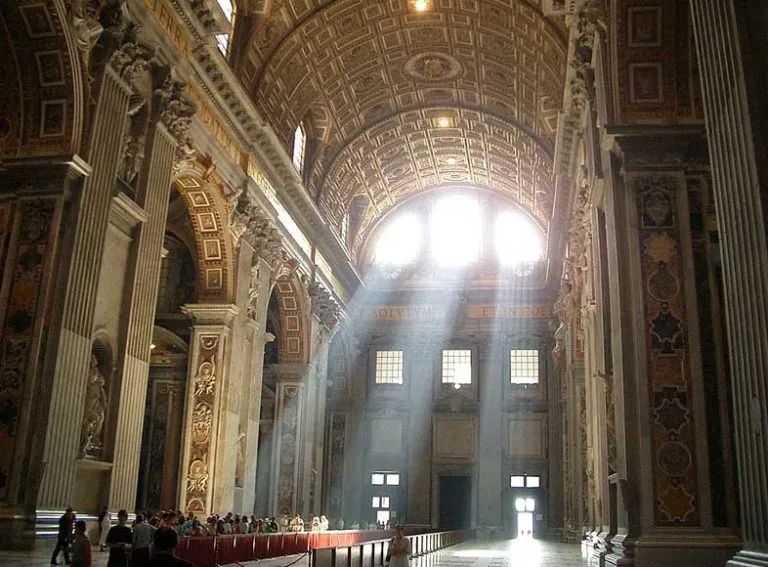
Status of St. Peter's Basilica
St. Peter’s Basilica is one of the papal basilicas and one of the four Major Basilicas of Rome, the other Major Basilicas (all of which are also Papal Basilicas) being the Basilicas of St. John Lateran, St. Mary Major, and St. Paul outside the Walls. The rank of major basilica confers on St. Peter’s Basilica precedence before all minor basilicas worldwide. However, unlike all the other Papal Major Basilicas, it is wholly within the territory, and thus the sovereign jurisdiction, of the Vatican City State, and not that of Italy.
It is the most prominent building in the Vatican City. Its dome is a feature of the skyline of Rome. Probably the largest church in Christendom, it covers an area of 2.3 hectares (5.7 acres). One of the holiest sites of Christianity and Catholic Tradition, it is traditionally the burial site of its titular, St. Peter, who was the head of the twelve Apostles of Jesus and, according to tradition, the first Bishop of Antioch and later the first Bishop of Rome, rendering him the first Pope.
Although the New Testament does not mention St. Peter’s martyrdom in Rome, tradition, based on the writings of the Fathers of the Church, holds that his tomb is below the baldachin and the altar of the Basilica in the “Confession”. For this reason, many Popes have, from the early years of the Church, been buried near Pope St. Peter in the necropolis beneath the Basilica. Construction of the current basilica, over the old Constantinian basilica, began on 18 April 1506 and finished in 1615. At length, on 18 November 1626 Pope Urban VIII solemnly dedicated the Basilica.
St. Peter’s Basilica is neither the Pope’s official seat nor first in rank among the Major Basilicas of Rome. This honour is held by the Pope’s cathedral, the Archbasilica of St. John Lateran which is the mother church of all churches in communion with the Catholic Church. However, St. Peter’s is certainly the Pope’s principal church in terms of use because most Papal liturgies and ceremonies take place there due to its size, proximity to the Papal residence, and location within the Vatican City proper.
The “Chair of Saint Peter”, or cathedra, an ancient chair sometimes presumed to have been used by St. Peter himself, but which was a gift from Charles the Bald and used by many popes, symbolizes the continuing line of apostolic succession from St. Peter to the reigning Pope. It occupies an elevated position in the apse of the Basilica, supported symbolically by the Doctors of the Church and enlightened symbolically by the Holy Spirit.
As one of the constituent structures of the historically and architecturally significant Vatican City, St. Peter’s Basilica was inscribed as a UNESCO World Heritage Site in 1984. With an exterior area of 21,095 square metres (227,060 sq ft), an interior area of 15,160 square metres (163,200 sq ft), St. Peter’s Basilica is the largest Christian church building in the world by the two latter metrics and the second largest by the first as of 2016. The top of its dome, at 448.1 feet (136.6 m), also places it as the second tallest building in Rome as of 2016.
The dome’s soaring height placed it among the tallest buildings of the Old World, and it continues to hold the title of tallest dome in the world. Though the largest dome in the world by diameter at the time of its completion, it no longer holds this distinction.
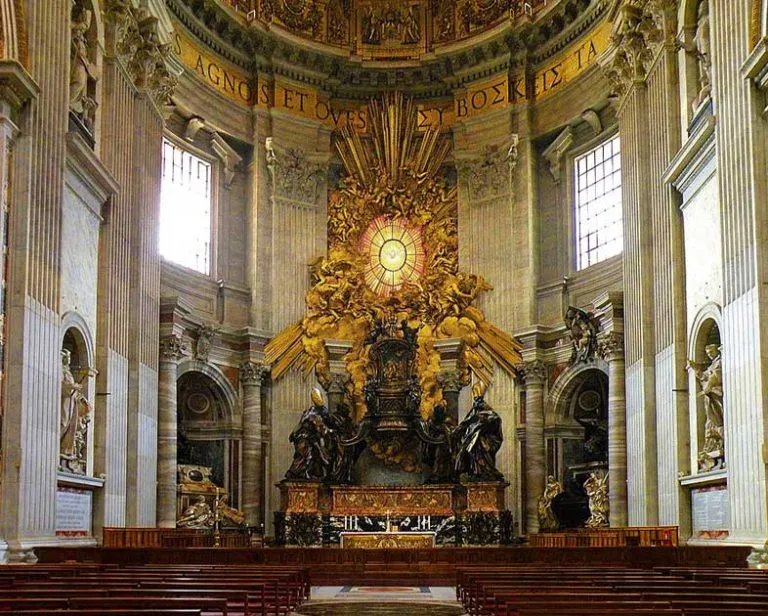
Saint Peter's Burial Site
After the crucifixion of Jesus, it is recorded in the Biblical book of the Acts of the Apostles that one of his twelve disciples, Simon known as Saint Peter, a fisherman from Galilee, took a leadership position among Jesus’ followers and was of great importance in the founding of the Christian Church. The name Peter is “Petrus” in Latin and “Petros” in Greek, deriving from “petra” which means “stone” or “rock” in Greek, and is the literal translation of the Aramaic “Kepa”, the name given to Simon by Jesus.
Catholic tradition holds that Peter, after a ministry of thirty-four years, travelled to Rome and met his martyrdom there along with Paul on 13 October 64 AD during the reign of the Roman Emperor Nero. His execution was one of the many martyrdoms of Christians following the Great Fire of Rome. According to Jerome, Peter was crucified head downwards, by his own request because he considered himself unworthy to die in the same manner as Jesus. The crucifixion took place near an ancient Egyptian obelisk in the Circus of Nero. The obelisk now stands in St. Peter’s Square and is revered as a “witness” to Peter’s death. It is one of several ancient Obelisks of Rome.
According to tradition, Peter’s remains were buried just outside the Circus, on the Mons Vaticanus across the Via Cornelia from the Circus, less than 150 metres (490 ft) from his place of death. The Via Cornelia was a road which ran east-to-west along the north wall of the Circus on land now covered by the southern portions of the Basilica and St. Peter’s Square. A shrine was built on this site some years later. Almost three hundred years later, Old St. Peter’s Basilica was constructed over this site.
The area now covered by the Vatican City had been a cemetery for some years before the Circus of Nero was built. It was a burial ground for the numerous executions in the Circus and contained many Christian burials because for many years after the burial of Saint Peter many Christians chose to be buried near Peter.
In 1939, in the reign of Pope Pius XII, 10 years of archaeological research began under the crypt of the basilica in an area inaccessible since the ninth century. The excavations revealed the remains of shrines of different periods at different levels, from Clement VIII (1594) to Callixtus II (1123) and Gregory I (590–604), built over an aedicula containing fragments of bones that were folded in a tissue with gold decorations, tinted with the precious murex purple. Although it could not be determined with certainty that the bones were those of Peter, the rare vestments suggested a burial of great importance. On 23 December 1950, in his pre-Christmas radio broadcast to the world, Pope Pius XII announced the discovery of Saint Peter’s tomb.
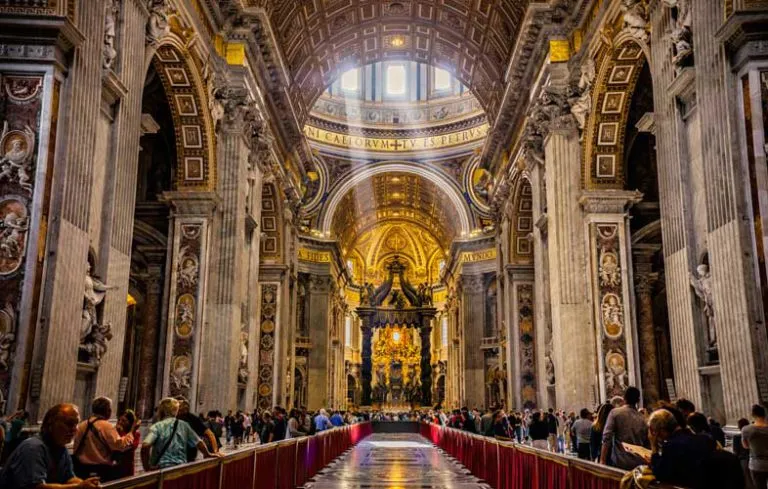
Old St. Peter's Basilica
Old St. Peter’s Basilica was the fourth-century church begun by the Emperor Constantine the Great between 319 and 333 AD. It was of typical basilical form, a wide nave and two aisles on each side and an apsidal end, with the addition of a transept or bema, giving the building the shape of a tau cross. It was over 103.6 metres (340 ft) long, and the entrance was preceded by a large colonnaded atrium. This church had been built over the small shrine believed to mark the burial place of St. Peter, though the tomb was “smashed” in 846 AD.
It contained a very large number of burials and memorials, including those of most of the popes from St. Peter to the 15th century. Like all of the earliest churches in Rome, both this church and its successor had the entrance to the east and the apse at the west end of the building. Since the construction of the current basilica, the name Old St. Peter’s Basilica has been used for its predecessor to distinguish the two buildings.
Plan to Rebuild
By the end of the 15th century, having been neglected during the period of the Avignon Papacy, the old basilica had fallen into disrepair. It appears that the first pope to consider rebuilding or at least making radical changes was Pope Nicholas V (1447–1455). He commissioned work on the old building from Leone Battista Alberti and Bernardo Rossellino and also had Rossellino design a plan for an entirely new basilica, or an extreme modification of the old. His reign was frustrated by political problems and when he died, little had been achieved.
He had, however, ordered the demolition of the Colosseum and by the time of his death, 2,522 cartloads of stone had been transported for use in the new building. The foundations were completed for a new transept and choir to form a domed Latin cross with the preserved nave and side aisles of the old basilica. Some walls for the choir had also been built.
Architecture
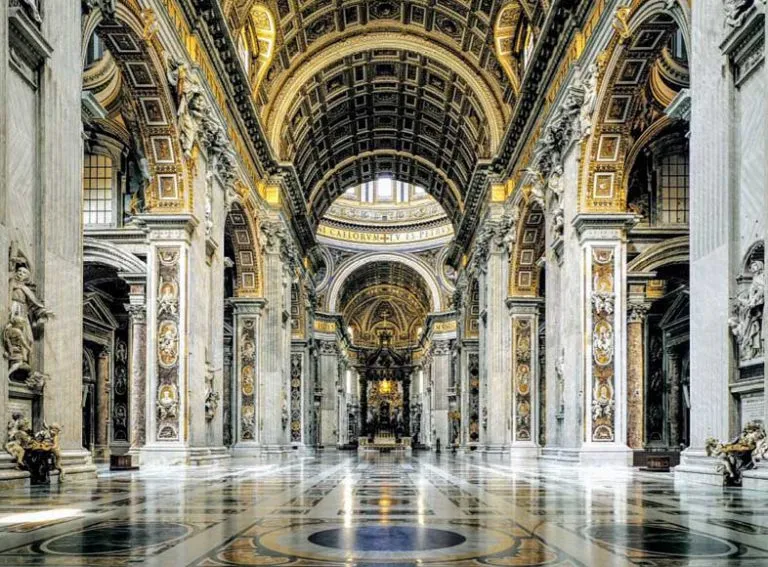
Pope Julius’ scheme for the grandest building in Christendom was the subject of a competition for which a number of entries remain intact in the Uffizi Gallery, Florence. It was the design of Donato Bramante that was selected, and for which the foundation stone was laid in 1506. This plan was in the form of an enormous Greek Cross with a dome inspired by that of the huge circular Roman temple, the Pantheon.
The main difference between Bramante’s design and that of the Pantheon is that where the dome of the Pantheon is supported by a continuous wall, that of the new basilica was to be supported only on four large piers. This feature was maintained in the ultimate design. Bramante’s dome was to be surmounted by a lantern with its own small dome but otherwise very similar in form to the Early Renaissance lantern of Florence Cathedral designed for Brunelleschi’s dome by Michelozzo.
Bramante had envisioned that the central dome would be surrounded by four lower domes at the diagonal axes. The equal chancel, nave and transept arms were each to be of two bays ending in an apse. At each corner of the building was to stand a tower, so that the overall plan was square, with the apses projecting at the cardinal points. Each apse had two large radial buttresses, which squared off its semi-circular shape.
When Pope Julius died in 1513, Bramante was replaced with Giuliano da Sangallo and Fra Giocondo, who both died in 1515. Raphael was confirmed as the architect of St. Peter’s on 1 August 1514. The main change in his plan is the nave of five bays, with a row of complex apsidal chapels off the aisles on either side. Raphael’s plan for the chancel and transepts made the squareness of the exterior walls more definite by reducing the size of the towers, and the semi-circular apses more clearly defined by encircling each with an ambulatory.
In 1520 Raphael also died, aged 37, and his successor Baldassare Peruzzi maintained changes that Raphael had proposed to the internal arrangement of the three main apses, but otherwise reverted to the Greek Cross plan and other features of Bramante. This plan did not go ahead because of various difficulties of both Church and state. In 1527 Rome was sacked and plundered by Emperor Charles V. Peruzzi died in 1536 without his plan being realized.
At this point Antonio da Sangallo the Younger submitted a plan which combines features of Peruzzi, Raphael and Bramante in its design and extends the building into a short nave with a wide façade and portico of dynamic projection. His proposal for the dome was much more elaborate of both structure and decoration than that of Bramante and included ribs on the exterior. Like Bramante, Sangallo proposed that the dome be surmounted by a lantern which he redesigned to a larger and much more elaborate form. Sangallo’s main practical contribution was to strengthen Bramante’s piers which had begun to crack.
On 1 January 1547 in the reign of Pope Paul III, Michelangelo, then in his seventies, succeeded Sangallo the Younger as “Capomaestro”, the superintendent of the building program at St Peter’s. He is to be regarded as the principal designer of a large part of the building as it stands today, and as bringing the construction to a point where it could be carried through.
He did not take on the job with pleasure; it was forced upon him by Pope Paul, frustrated at the death of his chosen candidate, Giulio Romano and the refusal of Jacopo Sansovino to leave Venice. Michelangelo wrote, “I undertake this only for the love of God and in honour of the Apostle.” He insisted that he should be given a free hand to achieve the ultimate aim by whatever means he saw fit.
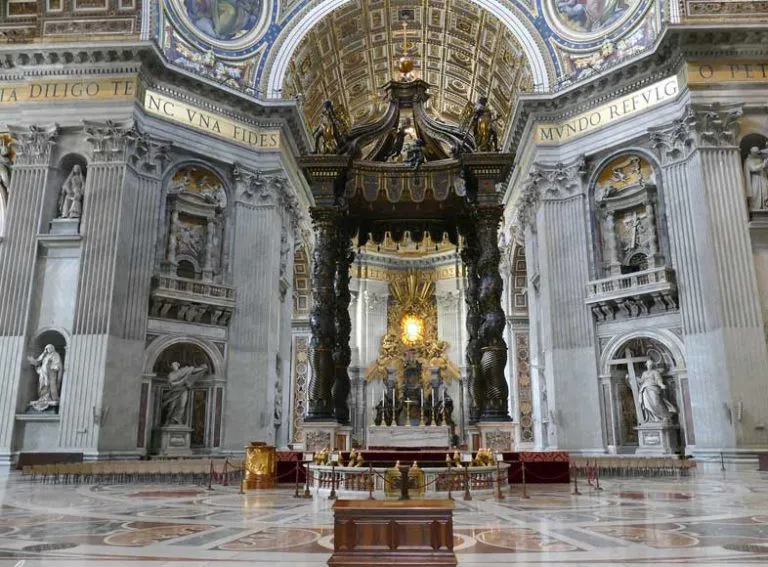
Michelangelo's Contribution
Michelangelo took over a building site at which four piers, enormous beyond any constructed since ancient Roman times, were rising behind the remaining nave of the old basilica. He also inherited the numerous schemes designed and redesigned by some of the greatest architectural and engineering minds of the 16th century.
There were certain common elements in these schemes. They all called for a dome to equal that engineered by Brunelleschi a century earlier and which has since dominated the skyline of Renaissance Florence, and they all called for a strongly symmetrical plan of either Greek Cross form, like the iconic St. Mark’s Basilica in Venice, or of a Latin Cross with the transepts of identical form to the chancel, as at Florence Cathedral.
Even though the work had progressed only a little in 40 years, Michelangelo did not simply dismiss the ideas of the previous architects. He drew on them in developing a grand vision. Above all, Michelangelo recognized the essential quality of Bramante’s original design. He reverted to the Greek Cross and, as Helen Gardner expresses it: “Without destroying the centralising features of Bramante’s plan, Michelangelo, with a few strokes of the pen converted its snowflake complexity into massive, cohesive unity.”
As it stands today, St. Peter’s has been extended with a nave by Carlo Maderno. It is the chancel end (the ecclesiastical “Eastern end”) with its huge centrally placed dome that is the work of Michelangelo. Because of its location within the Vatican State and because the projection of the nave screens the dome from sight when the building is approached from the square in front of it, the work of Michelangelo is best appreciated from a distance. What becomes apparent is that the architect has greatly reduced the clearly defined geometric forms of Bramante’s plan of a square with square projections, and also of Raphael’s plan of a square with semi-circular projections.
Michelangelo has blurred the definition of the geometry by making the external masonry of massive proportions and filling in every corner with a small vestry or stairwell. The effect created is of a continuous wall surface that is folded or fractured at different angles, but lacks the right angles which usually define change of direction at the corners of a building. This exterior is surrounded by a giant order of Corinthian pilasters all set at slightly different angles to each other, in keeping with the ever-changing angles of the wall’s surface. Above them, the huge cornice ripples in a continuous band, giving the appearance of keeping the whole building in a state of compression.
Dome: Successive and Final Designs
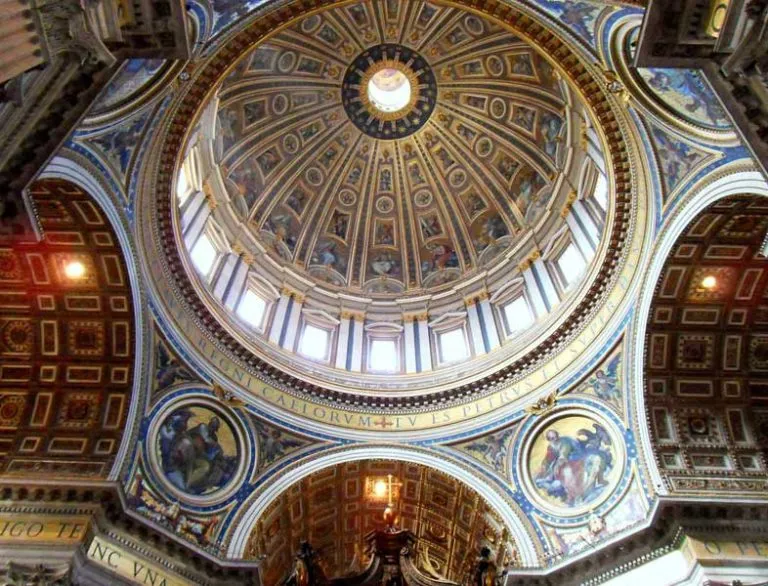
The dome of St. Peter’s rises to a total height of 136.57 metres (448.1 ft) from the floor of the basilica to the top of the external cross. It is the tallest dome in the world.[note 5] Its internal diameter is 41.47 metres (136.1 ft), slightly smaller than two of the three other huge domes that preceded it, those of the Pantheon of Ancient Rome, 43.3 metres (142 ft), and Florence Cathedral of the Early Renaissance, 44 metres (144 ft). It has a greater diameter by approximately 30 feet (9.1 m) than Constantinople’s Hagia Sophia church, completed in 537.
It was to the domes of the Pantheon and Florence duomo that the architects of St. Peter’s looked for solutions as to how to go about building what was conceived, from the outset, as the greatest dome of Christendom.
Bramante and Sangallo, 1506 and 1513
The dome of the Pantheon stands on a circular wall with no entrances or windows except a single door. The whole building is as high as it is wide. Its dome is constructed in a single shell of concrete, made light by the inclusion of a large amount of the volcanic stones tuff and pumice. The inner surface of the dome is deeply coffered which has the effect of creating both vertical and horizontal ribs while lightening the overall load. At the summit is an ocular opening 8 metres (26 ft) across which provides light to the interior.
Bramante’s plan for the dome of St. Peter’s (1506) follows that of the Pantheon very closely, and like that of the Pantheon, was designed to be constructed in Tufa Concrete for which he had rediscovered a formula. With the exception of the lantern that surmounts it, the profile is very similar, except that in this case, the supporting wall becomes a drum raised high above ground level on four massive piers. The solid wall, as used at the Pantheon, is lightened at St. Peter’s by Bramante piercing it with windows and encircling it with a peristyle.
In the case of Florence Cathedral, the desired visual appearance of the pointed dome existed for many years before Brunelleschi made its construction feasible. Its double-shell construction of bricks locked together in a herringbone pattern, and the gentle upward slope of its eight stone ribs made it possible for the construction to take place without the massive wooden formwork necessary to construct hemispherical arches. While its appearance, with the exception of the details of the lantern, is entirely Gothic, its engineering was highly innovative, and the product of a mind that had studied the huge vaults and remaining dome of Ancient Rome.
Sangallo’s plan (1513), of which a large wooden model still exists, looks to both these predecessors. He realized the value of both the coffering at the Pantheon and the outer stone ribs at Florence Cathedral. He strengthened and extended the peristyle of Bramante into a series of arched and ordered openings around the base, with a second such arcade set back in a tier above the first. In his hands, the rather delicate form of the lantern, based closely on that in Florence, became a massive structure, surrounded by a projecting base, a peristyle and surmounted by a spire of conic form. According to James Lees-Milne the design was “too eclectic, too pernickety and too tasteless to have been a success”.
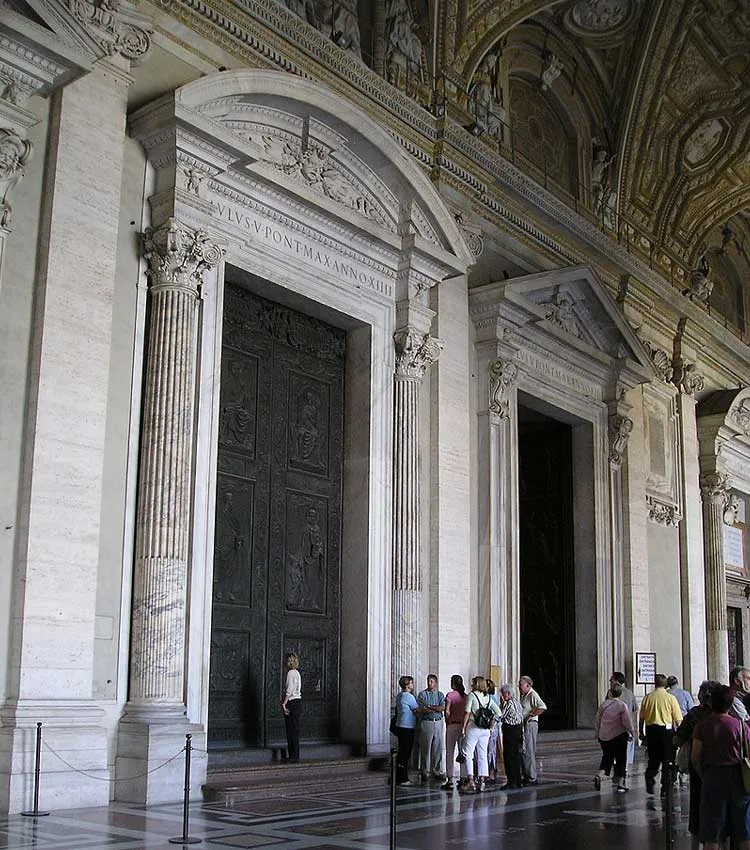
Addition of Nave and Facade
On 18 February 1606, under Pope Paul V, the dismantling of the remaining parts of the Constantine basilica began. The marble cross that had been set at the top of the pediment by Pope Sylvester and Constantine the Great was lowered to the ground. The timbers were salvaged for the roof of the Borghese Palace and two rare black marble columns, the largest of their kind, were carefully stored and later used in the narthex. The tombs of various popes were opened, treasures removed and plans made for re-interment in the new basilica.
The Pope had appointed Carlo Maderno in 1602. He was a nephew of Domenico Fontana and had demonstrated himself as a dynamic architect. Maderno’s idea was to ring Michelangelo’s building with chapels, but the Pope was hesitant about deviating from the master’s plan, even though he had been dead for forty years.
The Fabbrica or building committee, a group drawn from various nationalities and generally despised by the Curia who viewed the basilica as belonging to Rome rather than Christendom, were in a quandary as to how the building should proceed. One of the matters that influenced their thinking was the Counter-Reformation which increasingly associated a Greek Cross plan with paganism and saw the Latin Cross as truly symbolic of Christianity. The central plan also did not have a “dominant orientation toward the east.”
Another influence on the thinking of both the Fabbrica and the Curia was a certain guilt at the demolition of the ancient building. The ground on which it and its various associated chapels, vestries and sacristies had stood for so long was hallowed. The only solution was to build a nave that encompassed the whole space. In 1607 a committee of ten architects was called together, and a decision was made to extend Michelangelo’s building into a nave. Maderno’s plans for both the nave and the facade were accepted.
The building of the nave began on 7 May 1607, and proceeded at a great rate, with an army of 700 labourers being employed. The following year, the façade was begun, in December 1614 the final touches were added to the stucco decoration of the vault and early in 1615 the partition wall between the two sections was pulled down. All the rubble was carted away, and the nave was ready for use by Palm Sunday.
Bernini's Towers
Pope Urban had long been a critic of Bernini’s predecessor, Carlo Maderno. His disapproval of the architect’s work stemmed largely from Maderno’s design for the longitudinal nave of St. Peters, which was widely condemned for obscuring Michelangelo’s dome. When the Pope gave the commission to Bernini he therefore requested that a new design for the facade’s bell towers to be submitted for consideration. Baldinucci describes Bernini’s tower as consisting of “two orders of columns and pilasters, the first order being Corinthian” and “a third or attic story formed of pilasters and two columns on either side of the open archway in the center”.
Pope Urban desired the towers to be completed by a very specific date: 29 June 1641, the feast day dedicated to Saints Peter and Paul. To this end an order was issued which stated that “all work should take a second seat to that of the campanile”.
The south tower was completed on time even in spite of these issues, but records show that in the wake of the unveiling the Pope was not content with what he saw and he ordered the top level of Bernini’s tower removed so that the structure could be made even grander. The tower continued to grow, and as the construction began to settle, the first cracks started to appear followed by Urban’s infamous public admonishment of his architect.
In 1642 all work on both towers came to a halt. Bernini had to pay the cost for the demolition; eventually the idea of completing the bell towers was abandoned.
St. Peter's Piazza
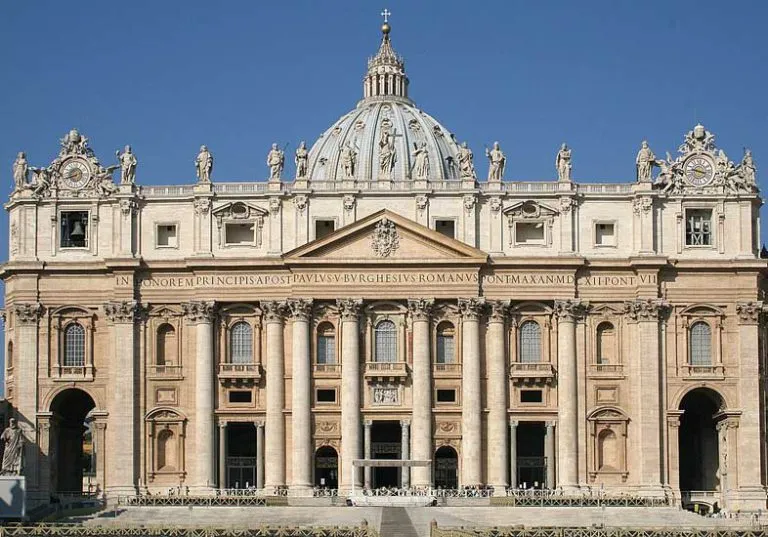
To the east of the basilica is the Piazza di San Pietro, (St. Peter’s Square). The present arrangement, constructed between 1656 and 1667, is the Baroque inspiration of Bernini who inherited a location already occupied by an Egyptian obelisk which was centrally placed, (with some contrivance) to Maderno’s facade. The obelisk, known as “The Witness”, at 25.31 metres (83.0 ft) and a total height, including base and the cross on top, of 40 metres (130 ft), is the second largest standing obelisk, and the only one to remain standing since its removal from Egypt and re-erection at the Circus of Nero in 37 AD, where it is thought to have stood witness to the crucifixion of Saint Peter.
Its removal to its present location by order of Pope Sixtus V and engineered by Domenico Fontana on 28 September 1586, was an operation fraught with difficulties and nearly ending in disaster when the ropes holding the obelisk began to smoke from the friction. Fortunately this problem was noticed by Benedetto Bresca, a sailor of Sanremo, and for his swift intervention, his town was granted the privilege of providing the palms that are used at the basilica each Palm Sunday.
The other object in the old square with which Bernini had to contend was a large fountain designed by Maderno in 1613 and set to one side of the obelisk, making a line parallel with the facade. Bernini’s plan uses this horizontal axis as a major feature of his unique, spatially dynamic and highly symbolic design.
The most obvious solutions were either a rectangular piazza of vast proportions so that the obelisk stood centrally and the fountain could be included, or a trapezoid piazza which fanned out from the facade of the basilica like that in front of the Palazzo Pubblico in Siena. The problems of the square plan are that the necessary width to include the fountain would entail the demolition of numerous buildings, including some of the Vatican, and would minimize the effect of the facade. The trapezoid plan, on the other hand, would maximize the apparent width of the facade, which was already perceived as a fault of the design.
Bernini’s ingenious solution was to create a piazza in two sections. That part which is nearest the basilica is trapezoid, but rather than fanning out from the facade, it narrows. This gives the effect of countering the visual perspective. It means that from the second part of the piazza, the building looks nearer than it is, the breadth of the facade is minimized and its height appears greater in proportion to its width. The second section of the piazza is a huge elliptical circus which gently slopes downwards to the obelisk at its centre. The two distinct areas are framed by a colonnade formed by doubled pairs of columns supporting an entablature of the simple Tuscan Order.
The part of the colonnade that is around the ellipse does not entirely encircle it, but reaches out in two arcs, symbolic of the arms of “the Catholic Church reaching out to welcome its communicants”. The obelisk and Maderno’s fountain mark the widest axis of the ellipse. Bernini balanced the scheme with another fountain in 1675.
The approach to the square used to be through a jumble of old buildings, which added an element of surprise to the vista that opened up upon passing through the colonnade. Nowadays a long wide street, the Via della Conciliazione, built by Mussolini after the conclusion of the Lateran Treaties, leads from the River Tiber to the piazza and gives distant views of St. Peter’s as the visitor approaches, with the basilica acting as a terminating vista.
Bernini’s transformation of the site is entirely Baroque in concept. Where Bramante and Michelangelo conceived a building that stood in “self-sufficient isolation”, Bernini made the whole complex “expansively relate to its environment”. Banister Fletcher says “No other city has afforded such a wide-swept approach to its cathedral church, no other architect could have conceived a design of greater nobility, the greatest of all atriums before the greatest of all churches of Christendom.”
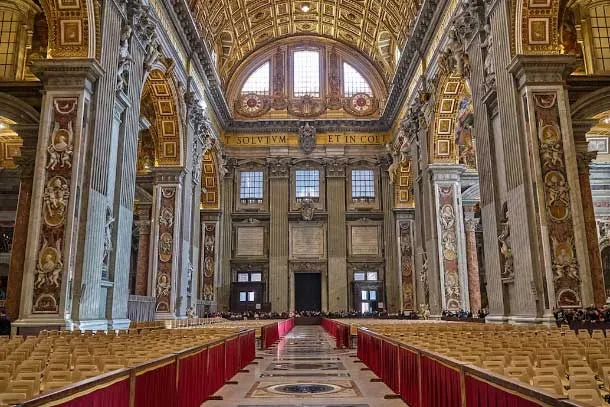
Clocks
The top of the facade of St. Peter’s Basilica has two clocks and several sculptures. The clocks were created to replace Bernini’s bell towers which had to be torn down due to insufficient support. The left clock shows Rome time, the one of the right shows European mean time. The statues are Christ the Redeemer, St. John the Baptist and 11 Apostles.
From the left: St. Thadeus, St. Matthew, St. Philip, St. Thomas, St. James the Greater, St. John the Baptist, The Redeemer, St. Andrew, St. John the Evangelist, St. James the Lesser, St. Bartholomew, St. Simeon, and St. Matthias. Above the Roman clock is the coat of arms for the city-state of Vatican City since 1931 held by two angels.
Bells
The Basilica has 6 bells, placed in the room under the Roman clock, only 3 of them are visible from ground level while the rest are hidden behind the bourdon. They range from the smallest which is 260 kg to the massive bourdon that approximately weighs 9 tonnes. From 1931, the bells are operated electrically, thus permitting even the largest bell to be tolled from a distance.
The oldest bell Rota dates from 1288 and the bourdon called Campanone is rung at Christmas and Easter, on the Solemnity of Sts. Peter and Paul, and every time the Pope imparts the “Urbi et Orbi” blessing to the city and to the world. Campanone also announces the election of a new pope.
Feast Day - 29th June
The feast dates back to the 3rd century and is to be distinguished from the day of Peter’s martyrdom celebrated on 29 June. The feast originated around the “cathedra” of Peter, the place where the Bishop of Rome resided and governed.
Mass Time
Weekdays
Sundays
Church Visiting Time
Contact Info
Piazza San Pietro, 00120,
Città del Vaticano, Vatican City
Phone No.
Tel : +39 06 6982
Accommodations
How to reach the Basilica
Giovan Battista Pastine International Airport also known as Rome–Ciampino International Airport “G. B. Pastine”, is located at Rome, Italy is the nearby Airport to the Basilica.
Risorgimento S. Pietro Transit Stop in Rome, Italy is the nearby Transit Station to the Basilica.

